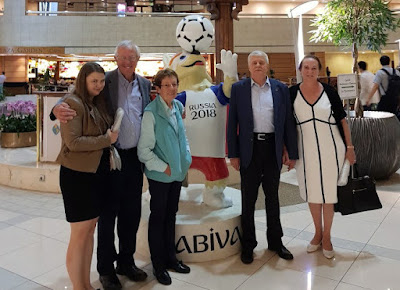In case you didn't see the last newsletter, here is a reminder of what's happened: Our subscriber list host, Topica, seems to have disappeared from the face of the internet with no warning. This means that we did not have time to retrieve our most current subscriber list from their servers.
Rather than risk spamming people who are on our old list, we have taken the decision to build up our subscriber list from scratch. If you wish to be added/re-added to the list, please email amanda@min-eng.com with the subject line: email list.
Whilst we build our list back up, the newsletter will be posted on the MEI Blog, MEI's LinkedIn page and anywhere else I can find for it!
For those of you reading who weren't subscribers, MEI Online Update is produced every 2 weeks and contains links to every new item added to MEI Online since the last issue - apart from jobs, which are listed in a separate email.
And in other news, there have been new additions to the Process Mineralogy '18 and Hi-Tech Metals '18 programmes, and there are only 3 booths left at the Process Mineralogy '18 exhibition. Please email Jon@min-eng.com for more details.
I mentioned in the last newsletter that Wolf Minerals would be running a trip to their Drakelands Mine following Physical Separation '19, and am happy to say that Barry will be blogging the details on Monday.
Barry's Blog:
* The Opening of the Newly Expanded Mineral Processing Facilities at Wardell Armstrong
* ‘The war on waste’: How could the mining industry respond?
* International chemical company Clariant to sponsor Flotation '19
* Last of the summer sundowners
* Major IMPC Awards to two distinguished American Professors
* How were your first two days at the Moscow IMPC?
* Conference nostalgia: Minerals Engineering '98 in Edinburgh
* The Starkeys call in en route to Moscow
* Exploring Cornwall's mining heritage with the Julian Baring Scholarship Fund
Best regards,
Amanda
amanda@min-eng.com
http://www.linkedin.com/amandawills
http://www.facebook.com/MEIConferences
https://twitter.com/MEIchat
*********************************
* Call for Papers: Physical Separation '19
*********************************
Analytical Techniques & Applied Mineralogy
~~~~~~~~~~~~~~~~~~~~~~~~~~~~~
* Technical Programme: Process Mineralogy '18
* Register Now: Process Mineralogy '18
* Recently Refereed Publication:
Minerals Engineering Vol.125
Analytical Techniques & Applied Mineralogy is sponsored by FEI
Biotechnology
~~~~~~~~~
* First Announcement: Biomining '20
Comminution
~~~~~~~~~
* First Announcement: Comminution '20
* Recently Refereed Publications:
Minerals Engineering Vol.125
Powder Technology Vol.337
Comminution is sponsored by Russell Mineral Equipment
Computer Applications
~~~~~~~~~~~~~~~
* First Announcement: Computational Modelling '19
* Recently Refereed Publications:
Minerals Engineering Vol.125
Powder Technology Vol.337
Environmental Issues
~~~~~~~~~~~~~~
* Technical Programme: Hi-Tech Metals '18
* Register Now: Hi-Tech Metals '18
* Recently Refereed Publication:
Minerals Engineering Vol.125
Froth Flotation
~~~~~~~~~~
* First Announcement: Flotation '19
* Commencement of Flotation Commissioning at the Hellyer Polymetallic Project, Tasmania
* Recently Refereed Publication:
Minerals Engineering Vol.125
Froth Flotation is sponsored by FLSmidth
General Minerals Engineering
~~~~~~~~~~~~~~~~~~~
* Technical Programme: Hi-Tech Metals '18
* Register Now: Hi-Tech Metals '18
* Conference Report: 2nd Young Nonferrous Metals Scientists & Engineers Forum
* Recently Refereed Publication:
Minerals Engineering Vol.125
Gravity Concentration
~~~~~~~~~~~~~~
* Call for Papers: Physical Separation '19
* Recently Refereed Publication:
Minerals Engineering Vol.125
Hydrometallurgy
~~~~~~~~~~~
* First Announcement: Biomining '20
* Lithium Ion Exchange Provides a New Source for Battery Materials
* Recently Refereed Publications:
Minerals Engineering Vol.125
Chemical Engineering Science Vol.191
Journal of Cleaner Production Vol.197
Magnetic/Electrical Separation
~~~~~~~~~~~~~~~~~~~~
* Call for Papers: Physical Separation '19
* Recently Refereed Publication:
Minerals Engineering Vol.125
Magnetic/Electrical Separation is sponsored by SLon Magnetic Separator
Reagents
~~~~~~
* Recently Refereed Publication:
Minerals Engineering Vol.125
Reagents is sponsored by Axis House
Sizing, Classification & Sorting
~~~~~~~~~~~~~~~~~~~~
* Call for Papers: Physical Separation '19
Solid-Liquid Separation
~~~~~~~~~~~~~~~
* Call for Papers: Physical Separation '19
Solid-Liquid Separation is sponsored by FLSmidth
Plant Operations
~~~~~~~~~~~
* China's Western Mining to Launch Qinghai Copper Smelter Next Month
Plant Operations News Australasia is sponsored by Magotteaux
Plant Operations News Europe is sponsored by Holman-Wilfley
People News
~~~~~~~~
* J. Burgess Winter 1933-2018
* Major IMPC Awards to Two Distinguished American Professors
* IMA Medal of Excellence in Mineralogical Services 2017 goes to Emil Makovicky
* John Van Nostrand Dorr joins the IM Technology Hall of Fame: Concentration
* Join the Minerals Engineers LinkedIn Group
People News Australia is sponsored by JKMRC & JKTech
Commodities
~~~~~~~~~
New items in:
* Calcium Carbonate - Refereed Publications
* Copper - News
* Copper - Refereed Publications
* Gold - News
* Gold - Refereed Publications
* Iron - Refereed Publications
* Kaolin - Refereed Publications
* Lithium - News
* Lithium - Refereed Publications
* Manganese - Refereed Publications
* Nickel - Refereed Publications
* Platinum Group Metals - Refereed Publications
* Quartz - Refereed Publications
* Rare Earths & Thorium - Refereed Publications
* Tungsten - Refereed Publications
* Vanadium - Refereed Publications
* Zinc - Refereed Publications
Cobalt, Copper, Rare Earths & Thorium sections are sponsored by Axis House
Minerals Engineering Conferences
~~~~~~~~~~~~~~~~~~~~~~
* Technical Programme: Process Mineralogy '18
* Register Now: Process Mineralogy '18
* Technical Programme: Hi-Tech Metals '18
* Register Now: Hi-Tech Metals '18
* Call for Papers: Computational Modelling '19
* Call for Papers: Physical Separation '19
* First Announcement: Flotation '19
* First Announcement: Comminution '20
* First Announcement: Biomining '20













































-EDIT.jpg)











